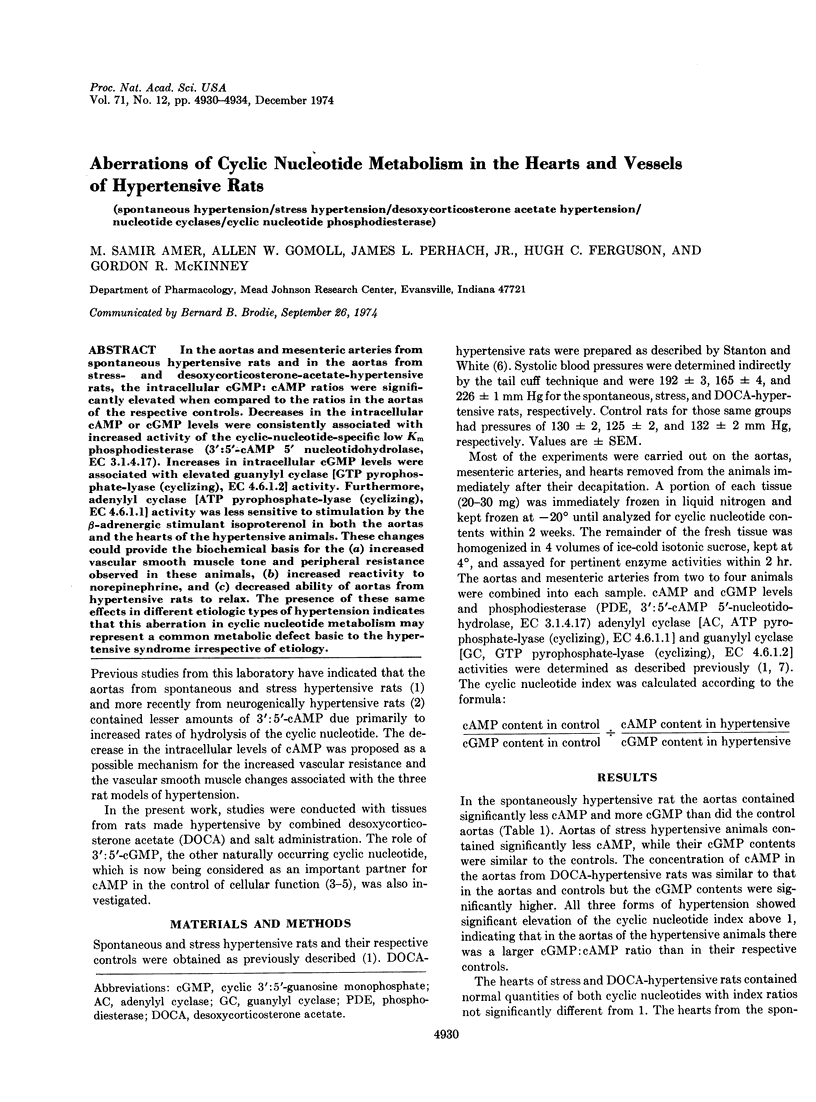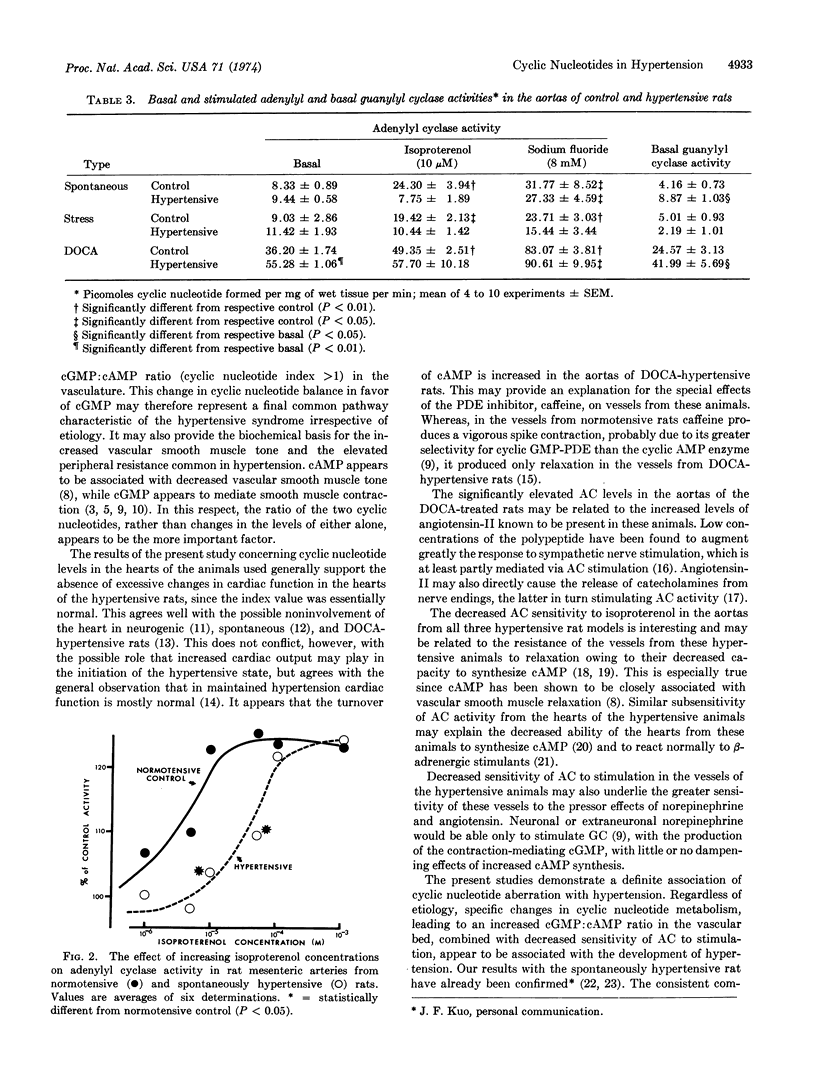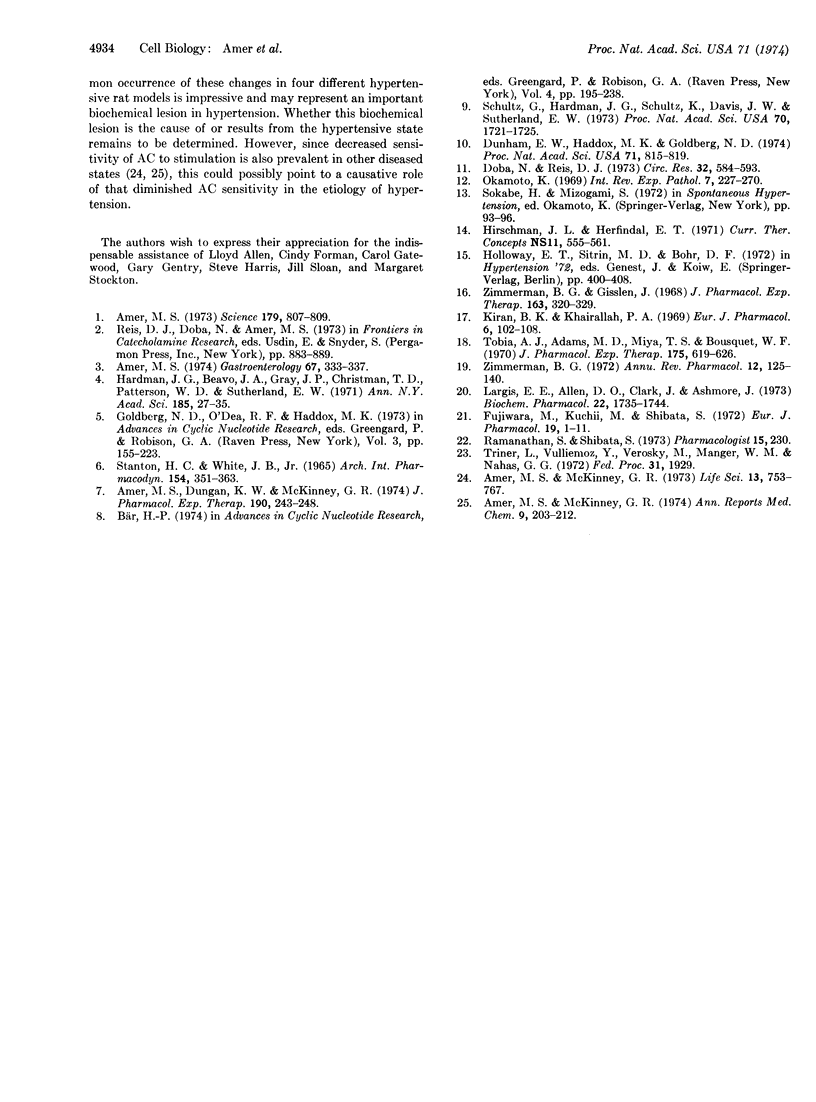Abstract
In the aortas and mesenteric arteries from spontaneous hypertensive rats and in the aortas from stress- and desoxycorticosterone-acetate-hypertensive rats, the intracellular cGMP: cAMP ratios were significantly elevated when compared to the ratios in the aortas of the respective controls. Decreases in the intracellular cAMP or cGMP levels were consistently associated with increased activity of the cyclic-nucleotide-specific low Km phosphodiesterase (3′:5′-cAMP 5′ nucleotidohydrolase, EC 3.1.4.17). Increases in intracellular cGMP levels were associated with elevated guanylyl cyclase [GTP pyrophosphate-lyase (cyclizing), EC 4.6.1.2] activity. Furthermore, adenylyl cyclase [ATP pyrophosphate-lyase (cyclizing), EC 4.6.1.1] activity was less sensitive to stimulation by the β-adrenergic stimulant isoproterenol in both the aortas and the hearts of the hypertensive animals. These changes could provide the biochemical basis for the (a) increased vascular smooth muscle tone and peripheral resistance observed in these animals, (b) increased reactivity to norepinephrine, and (c) decreased ability of aortas from hypertensive rats to relax. The presence of these same effects in different etiologic types of hypertension indicates that this aberration in cyclic nucleotide metabolism may represent a common metabolic defect basic to the hypertensive syndrome irrespective of etiology.
Keywords: spontaneous hypertension, stress hypertension, desoxycorticosterone acetate hypertension, nucleotide cyclases, cyclic nucleotide phosphodiesterase
Full text
PDF




Images in this article
Selected References
These references are in PubMed. This may not be the complete list of references from this article.
- Amer M. S. Cyclic adenosine monophosphate and hypertension in rats. Science. 1973 Feb 23;179(4075):807–809. doi: 10.1126/science.179.4075.807. [DOI] [PubMed] [Google Scholar]
- Amer M. S. Cyclic guanosine 3',5'-monophosphate and gallbladder contraction. Gastroenterology. 1974 Aug;67(2):333–337. [PubMed] [Google Scholar]
- Amer M. S., Dungan K. W., McKinney G. R. The effects of isoxsuprine hydrochloride on the cyclic nucleotide system in the rat uterus. J Pharmacol Exp Ther. 1974 Aug;190(2):243–248. [PubMed] [Google Scholar]
- Amer M. S., McKinney G. R. Possibilities for drug development based on the cyclic AMP system. Life Sci. 1973 Oct 1;13(7):753–767. doi: 10.1016/0024-3205(73)90066-0. [DOI] [PubMed] [Google Scholar]
- Doba N., Reis D. J. Acute fulminating neurogenic hypertension produced by brainstem lesions in the rat. Circ Res. 1973 May;32(5):584–593. doi: 10.1161/01.res.32.5.584. [DOI] [PubMed] [Google Scholar]
- Dunham E. W., Haddox M. K., Goldberg N. D. Alteration of vein cyclic 3':5' nucleotide concentrations during changes in contractility. Proc Natl Acad Sci U S A. 1974 Mar;71(3):815–819. doi: 10.1073/pnas.71.3.815. [DOI] [PMC free article] [PubMed] [Google Scholar]
- Fujiwara M., Kuchii M., Shibata S. Differences of cardiac reactivity between spontaneously hypertensive and normotensive rats. Eur J Pharmacol. 1972 Jul;19(1):1–11. doi: 10.1016/0014-2999(72)90070-2. [DOI] [PubMed] [Google Scholar]
- Goldberg N. D., O'Dea R. F., Haddox M. K. Cyclic GMP. Adv Cyclic Nucleotide Res. 1973;3:155–223. [PubMed] [Google Scholar]
- Hardman J. G., Beavo J. A., Gray J. P., Chrisman T. D., Patterson W. D., Sutherland E. W. The formation and metabolism of cyclic GMP. Ann N Y Acad Sci. 1971 Dec 30;185:27–35. doi: 10.1111/j.1749-6632.1971.tb45232.x. [DOI] [PubMed] [Google Scholar]
- Hirschman J. L., Herfindal E. T. Essential hypertension. J Am Pharm Assoc. 1971 Oct;11(10):555–561. doi: 10.1016/s0003-0465(16)31792-x. [DOI] [PubMed] [Google Scholar]
- Kiran B. K., Khairallah P. A. Angiotensin and norepinephrine efflux. Eur J Pharmacol. 1969 May;6(2):102–108. doi: 10.1016/0014-2999(69)90204-0. [DOI] [PubMed] [Google Scholar]
- Largis E. E., Allen D. O., Clark J., Ashmore J. Isoproterenol and glucagon effects in perfused hearts from spontaneously hypertensive and normotensive rats. Biochem Pharmacol. 1973 Jul 15;22(14):1735–1744. doi: 10.1016/0006-2952(73)90387-0. [DOI] [PubMed] [Google Scholar]
- Okamoto K. Spontaneous hypertension in rats. Int Rev Exp Pathol. 1969;7:227–270. [PubMed] [Google Scholar]
- Schultz G., Hardman J. G., Schultz K., Davis J. W., Sutherland E. W. A new enzymatic assay for guanosine 3':5'-cyclic monophosphate and its application to the ductus deferens of the rat. Proc Natl Acad Sci U S A. 1973 Jun;70(6):1721–1725. doi: 10.1073/pnas.70.6.1721. [DOI] [PMC free article] [PubMed] [Google Scholar]
- Stanton H. C., White J. B., Jr Hypotensive actions of drugs on unanesthetized normotensive and "metacorticoid" hypertensive rats determined by a direct recording technique. Arch Int Pharmacodyn Ther. 1965 Apr;154(2):351–363. [PubMed] [Google Scholar]
- Tobia A. J., Adams M. D., Miya T. S., Bousquet W. F. Altered reflex vasodilatation in the hypertensive rat: possible role of histamine. J Pharmacol Exp Ther. 1970 Dec;175(3):619–626. [PubMed] [Google Scholar]
- Zimmerman B. G. Drug action of peripheral vascular system. Annu Rev Pharmacol. 1972;12:125–140. doi: 10.1146/annurev.pa.12.040172.001013. [DOI] [PubMed] [Google Scholar]
- Zimmerman B. G., Gisslen J. Pattern of renal vasoconstriction and transmitter release during sympathetic stimulation in presence of angiotensin and cocaine. J Pharmacol Exp Ther. 1968 Oct;163(2):320–329. [PubMed] [Google Scholar]





